A History of the County of Surrey: Volume 4. Originally published by Victoria County History, London, 1912.
This free content was digitised by double rekeying. All rights reserved.
'Croydon: Introduction and Croydon Palace', in A History of the County of Surrey: Volume 4, (London, 1912) pp. 205-217. British History Online https://www.british-history.ac.uk/vch/surrey/vol4/pp205-217 [accessed 18 April 2024]
CROYDON
Croindeine (xi cent.); Crondon (xiii cent.).
Croydon is a parish of 9,012 acres lying 10 miles south of London on the London and Brighton road.
The neighbourhood of Croydon is very rich in prehistoric and early historic remains. On Croham Hurst and on Shirley Hills are neolithic hut floors, hut circles and hearths adjoining them, which have been explored and have yielded neolithic remains, implements, flakes, and animals' bones. Mr.G. Clinch explored many of them about 1899, also similar remains not far away over the Kentish border, and communicated the results to the Anthropological Institute. (fn. 1) At Waddon in 1903 a discovery was made of three beehive-shaped chambers in the Thanet Sand, of a kind unknown elsewhere in England. They were approached by horizontal passages terminating in the slope of a hill. They contained animals' bones and flint chips and flakes of a greenish flint, which occurs naturally only at a lower level, and so could not have been washed in by rain. Mr. Clinch was of opinion that they were sepulchral in origin, of great antiquity, used as refuges or temporary abodes when their original purpose was forgotten. They were unfortunately destroyed by the same building operations which had led to their discovery. (fn. 2) A considerable hoard of bronze has been found at Wickham Park. (fn. 3) Besides these traces of early habitation there are remains which seem to point to an early road through Croydon. The Roman Way which comes from the south coast, probably from the mouth of the Ouse and from Pevensey by different branches, and runs through Godstone, must have passed near Croydon in its course to the Thames Valley. Before any Roman invasion it would seem that Marseilles merchants, or those who had traded with Marseilles merchants, may have used the same line, for at three different spots in or about Croydon there have been found in recent years an Athenian drachma of circa 400 B.C., a didrachma of the Greek city of Metapontum in Italy of circa 350 B.C., and a copper coin of Agathocles of Syracuse of after 307 B.C., when he had assumed the title of Basileus. Three coins of such different dates, occurring singly, suggest a line of traffic. Several hoards of Roman coins have been found at different times in Croydon. (fn. 4) In 1896, in Edridge Road, south of the town hall, a most valuable discovery was made of Teutonic, possibly Frankish, interments, with weapons, armour and pottery. (fn. 5) In Whitehorse Manor, between Thornton Heath and Selhurst, while the railway was being made, a great number of Anglo-Saxon coins of the 9th century were found, with a few Frankish coins of the same century and some Oriental coins, including some of the Khalif Haroun-al-Raschid—another indication of early commerce. (fn. 6) Mediaeval weapons, armour, and bones are also said to have been found at or near Croydon. (fn. 7)
In 1264 there was a brisk skirmish at Croydon, when the Londoners who had been driven off the field at Lewes, and were retreating homewards with unnecessary speed (as their side had in fact gained the victory), were attacked and defeated by the king's troops, who had evacuated Tonbridge Castle and were themselves retreating to the west of England. William the only son of John de Warenne Earl of Surrey was killed in 1286 at a tournament at Croydon, or on his way to the tournament, not without suspicion of foul play. (fn. 8)
The original village of Croydon, near the church, stood, as is usual, on the Thanet and Woolwich beds at the foot of the chalk. (fn. 9) Owing to the residence of the Archbishops of Canterbury, who made Croydon the centre for the management of the archiepiscopal estates in Surrey, Middlesex and Hertfordshire, the town had reached to some size and importance at a comparatively early date. In the 15th century shops were built in the market place and there were already an old and a new town. (fn. 10) The old or lower town was situated further from London than the present town, that is, towards Beddington, and according to Ducarel there were still remains of it in 1783. (fn. 11) The neighbourhood of the parish church down the hill may still be regarded as the older Croydon. The great extension of buildings up the hill, north and south of Whitgift's Hospital, was a consequence of the improvement of the road to East Grinstead and Rye by the Acts of 1717–18 (fn. 12) and 1723–4, (fn. 13) and the formation of the road through Croydon to Reigate and Brighton by Acts of 1769–70 (fn. 14) and 1807. (fn. 15) This line of road became the main line of communication with the south coast. But it is evident that the most important part of the town still lay down the hill in 1720, for although this road is marked on the map engraved in Ogilby's Roads with houses along it (where the present town stands), yet a side road turning off it to the west, just north of the buildings, is the one marked as leading to Croydon.
How early the Archbishops of Canterbury had a house at Croydon is uncertain. A deed dated at Croydon by Archbishop Kilwardby in 1273 (fn. 16) is generally quoted as the earliest evidence of an archiepiscopal residence, but, as the account of the architecture of the present palace shows, there was a house here at least a century earlier, and the archbishops may have had a residence even before that time. Archbishop Courtenay is mentioned to have received the pall in the 'principal room' of the manor of Croydon. (fn. 17) Most of the archbishops seem to have used the house more or less, (fn. 18) principally as a summer residence, and occasionally they entertained royal guests there. James I of Scotland dated a deed at Croydon in 1412, (fn. 19) when he was apparently staying at the palace in the custody of Archbishop Arundel. In 1573 Queen Elizabeth came to Croydon from Greenwich and stayed a week at the palace with all her attendants. (fn. 20) The house was convenient on account of the easy access to London, but after the Reformation it seems to have been considered unhealthy. When the question arose of the resignation of Archbishop Grindal (1576–83) a petition was made by him that he might retain this house, for although, 'he said, this was no wholesome house, and that both his predecessors and he found by experience, notwithstanding, because of its nearness to London, whither he must often repair, or send to have some help of physic, he knew no house so convenient for him.' (fn. 21) He died here soon after on 6 July 1583. His successors continued to use it for some time. In 1780, however, a Private Act of Parliament was passed, which set forth that the house was in so low and unwholesome a situation and in many respects so incommodious and unfit for an archbishop's house that few archbishops had of late years been able to reside there, and vested it with 2 closes of land containing 6 acres in the Lord High Chancellor and two other trustees for sale or to be pulled down. (fn. 22) On 10 October 1780 it was sold to Abraham Pitches of Streatham. (fn. 23) In 1818 the palace was used as a factory for printing linen, and the garden was turned into a bleaching ground. (fn. 24) Later parts of the palace were converted into private residences, the chapel was used as a girls' school of industry, and the great hall as a laundry. (fn. 25) In 1887, however, the palace was sold to the Duke of Newcastle and by him presented to the community of the Sisters of the Church, who now carry on a higher grade day school for girls there. A large part of the building has been re-roofed, and the banqueting hall has been restored. (fn. 26)
The palace adjoins the churchyard on the east, the western wall following the slant of the site from east to west. The buildings surround a northern and a southern courtyard, which they inclose on all four sides, while the great hall projects to the eastward of the main block. The buildings generally consist of a low basement with a principal floor above; the chapel on the north side of the north courtyard and the great parlour known as the 'guard-room' which divides the two courtyards are on this floor. Over some portions there is a third floor contained in the roof. The materials of the older parts are stone and flint rubble, while the later work is of brick. The roofs throughout are tiled. As already mentioned, the earliest mention of any building on the site is in 1273. That the nucleus of the present buildings dates from at least a hundred years earlier is shown by the many 12th-century stones, including an arch stone worked with the cheveron incorporated by the 15th-century masons in the substructure of the great parlour. Further, a small round-headed light with its adjacent walling has recently been discovered at the north end of the buildings on the west side of the southern court immediately adjoining the great parlour. This is of an earlier type than the stones in the substructure of the great parlour and the internal splay is on the north side, a fact which would seem to indicate that the original manor-house consisted of a hall on the site of the great parlour with a solar at the west end. Later in the 12th century a projecting wing may have been added at the south-west, by which this window would become an internal opening and would consequently be blocked as being of no further use. This probably contained a new solar with a chapel at the southern end, afterwards remodelled by Archbishop Courtenay at the end of the 14th century. The reasons for this supposition are given below. The foundations of this wing are probably followed by the buildings at this end of the south court; witness the great thickness of the walls and the inaccurate setting out of all this portion. In the absence of any but inferential proof of an earlier date the walls are marked as 14th and 15th century on the accompanying plan. It is impossible to follow the history of the building in the period intervening between the 12th and 14th centuries. It seems, however, that a new chapel was added on the north on the site of the present chapel between the 12th and 14th centuries, as by Courtenay's time (1381–96) the registers speak of a 'capella secretior . . . infra secretam cameram, juxta gardinam, jam de novo constructa,' a description which exactly fits the part of the basement marked on the plan as the original chapel, which is both on the ground floor and juxta gardinam, that is on the south side of the palace. The details moreover correspond exactly with the style of the late 14th century and the newel stair at the north-west would lead down from the camera secreta. All the buildings to the westward are of later date. The date, therefore, of the lower walls of the new chapel on the north, the capella principalis of the registers, is uncertain; these again, in the absence of any detail earlier than that period, have been marked as early 15th century on the plan. (fn. 27)
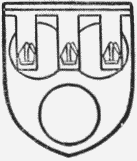
Courtenay. Or three roundels gules and a label azure with a mitre or upon each pendant.
Some portions of the lower part of the north wall of the great hall may belong to the 13th century, though this is very doubtful. It would rather seem that the whole of this addition belongs also to Courtenay's period, to which date the north-east porch is to be referred. At this end were the screens, with the kitchen and butteries adjoining. All this portion, which was doubtless of one story only, was removed early in the 19th century. The original hall, which had now fallen to the status of the great parlour, appears to have been rebuilt early in the 15th century by Archbishop Arundel (1396–1414), whose shield is carved on the stone corbels of the roof. In the middle of the same century the great hall was rebuilt, probably by Archbishop Stafford, whose arms occupy prominent positions. At this period the palace would have consisted of the great hall as it exists at present, with the now demolished offices at the east end; the great parlour connected with the great hall and a lost building to the west, probably the original solar, the quoins of which are still left on the north side; a chapel to the north, the lower walls of which still exist beneath the present chapel, probably connected with the great hall and parlour by a block of buildings at the east end, which were later rebuilt; and the buildings at the south-west of the great parlour, containing the secretior capella. All these buildings were of stone and flint rubble; for the next additions stone was discarded in favour of brick, when in all probability Archbishop Bourchier (1454–86) rebuilt the upper walls of the chapel in this material, lengthening it eastwards to its present extent, remodelled the connecting block between the chapel and the great parlour and added the eastern portion of the long gallery, thus inclosing the southern courtyard on three sides. This portion appears to be of half-timber construction, though it has been refaced with brick at a later period. At the close of the same century the palace assumed its present form, the chapel being lengthened westwards as far as the boundary of the churchyard, while the block of buildings to the southward following the slant of the site and comprising the rooms known as the 'diningroom' and the 'minstrels' gallery' was added. Thus the north courtyard was now inclosed on all four sides. At the same time the buildings between the great hall and the great parlour appear to have been entirely reconstructed and an addition made to the south-west, completing the long gallery range. This portion contains the rooms now known as the 'library' and 'Queen Elizabeth's room.' The building on the east side of the north courtyard connecting the chapel with the great hall and the great parlour appear also to have been again rebuilt. The material employed is red brick throughout with occasional diapering of blue brick. The clue to the author of these drastic alterations and additions is furnished by the screen in the chapel, which is shown to be of the same date by the exact similarity of its mouldings with those employed for the moulded joists of the ceilings, which form a distinctive feature of the whole work. In the running vine ornament of the cornice is the rebus of Archbishop Morton (1486–1500), a tun, on which doubtless was originally painted the first syllable of his name, as on a boss of the vault of the gateway of Morton's tower at Lambeth carved with the same rebus. Additional proof is furnished by the remarkable resemblance between the two buildings, the mouldings of the ceiling joists and stone window and door jambs being identical with those at Lambeth. In the first half of the 17th century the palace seems to have been modernized to suit the requirements of the time, when the present stairs were inserted throughout. Archbishop Juxon seems also to have repaired the fabric after the Commonwealth and to have made some new stalls for the chapel.
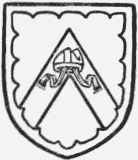
Stafford. Or a cheveron gules in a border engrailed sable with a mitre argent on the cheveron.
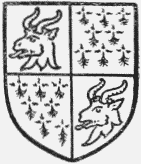
Morton. Quarterly gules and ermine with a goal's head argent having his horns or in each quarter of gules.
The Parliamentary Survey taken after the death of Archbishop Laud describes the palace or site of the manor, with a wainscoted chapel, the granary, stables, &c., as surrounded by a courtyard on the north, a small running water on the east and south, and the churchyard on the west. There was a large garden and fruit-house, and there were three fish ponds. (fn. 28) Archbishop Abbot (1611–33) cut down the wood from the front of the house to the highway, Wake (1716–37) rebuilt the south wall of the long gallery, and Herring (1747–57) repaired the palace and improved the garden. (fn. 29)
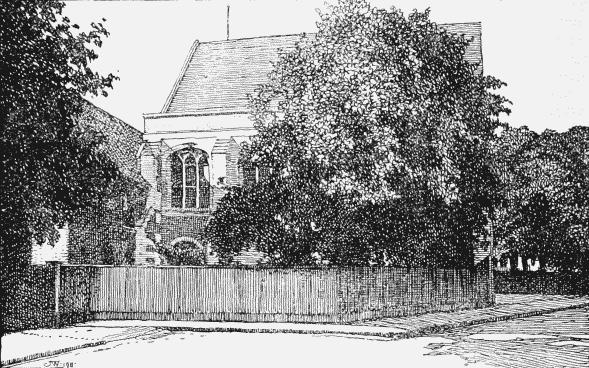
Archbishop's Palace, Croydon: The Great Hall from the South-east
The great hall, known as the 'banqueting' hall, measures internally 56 ft. by 38 ft. The greater part of the structure appears to belong to the middle of the 15th century, with the exception of the north-east doorway and porch, and possibly the lower part of the north wall, in the west bay of which the jamb of an earlier window and the segmental head of a blocked-up opening are still visible externally. The materials of the whole walling are flint rubble, with ashlar for the buttresses. Externally the north and south walls are plastered, the latter only above the sill level of the windows. There is a plain brick parapet of early bricks, perhaps a 16th-century addition. The hall is divided into four bays by the roof principals, the thrusts of which are taken by buttresses of two offsets on the north and south. In each of the bays thus formed, with the exception of the north-east bay, is a window of three uncusped lights within a four-centred head. The jambs are moulded with a bold casement internally and externally. All originally had external labels, but those of the south windows have mouldered away. These windows are placed high up in the wall, and internally, at the level of their sills, there is a moulded string course, interrupted only by the carved corbels which take the feet of the wallposts of the roof principals. In the west wall are three plain openings, lighting the first floor of the adjoining buildings. These probably date from the 17th century. The late 14th-century north-east doorway opening into the porch is of two continuously moulded orders of characteristic section, and has a two-centred external head and segmental rear arch. Immediately opposite in the south wall is a doorway with casement moulded jambs and two-centred head and a square external label and plain spandrels. This appears to be contemporary with Stafford's rebuilding. Here originally were the screens, with the entrances to the kitchen and butteries. These have now been blocked and plastered over internally, though the jambs of a wide opening are visible externally. The upper portion of the east wall, which was said to have windows of a 'lancet' type, (fn. 30) fell down in the year 1830. The east gable is now tile hung. In the west bay of the south wall, at the dais end, was formerly an oriel window, which is now destroyed. The arch opening to it is four-centred, and has ogee-moulded jambs. There is a 15th-century doorway at the north end of the west wall, nearly opposite the entrance to the great parlour. The head is two-centred with a square label, and the spandrels have foliage and blank shields. The corbels which take the feet of the wall-posts are sculptured with angels holding shields with the arms of Archbishop Stafford and others. These are as follows: on the corbels of the eastern wall truss (now reset with the canopy of Stafford's throne at the west end of the hall) Stafford and Bath and Wells (with the saltire cut off at the ends); on the next pair to the west, an unidentified coat on the north, and Stafford impaling Bath and Wells on the south; on the central pair, Henry Earl of Stafford and Duke of Buckingham on the north and on the south, Canterbury impaling Stafford; on the next pair the Duke of York (1415–60) on the north and Archbishop Herring (1747–57) on the south; and on the corbels of the western wall truss Canterbury impaling Juxon on the north and Canterbury impaling Laud on the south. The roof is supported by trusses with moulded collars supported by arched braces springing from wall-posts with moulded capitals and bases. The collars are placed at about half the height of the roof, and there are plain purlins supported by the principal rafters at the point of their junction with the collars. The common rafters are strutted vertically and horizontally from additional moulded purlins framed into the collars, the mouldings being mitred at their intersection. The common rafters have also plain braced collars near the apex of the roof, the upper half of which becomes virtually a trussed rafter roof, while lateral stiffness is secured in the lower half by curved wind braces. Additional ties were added by Archbishop Herring in 1748 at the level of the wall plate, each consisting of a pair of joists bolted together and cased. On those of the western truss are his initials with the date. Against the west wall are placed the fragments of Stafford's throne. These consist of a stone canopy carved and painted in imitation of drapery with a tasselled fringe, beneath which are angels supporting the arms of King Henry VI, Edward the Confessor impaling France and England quarterly. Below this again is the moulded capping of the throne-back, and in the centre are the arms of Stafford surmounted by an angel holding with outstretched arms a label inscribed 'D[omine] saluum fac regem.' The canopy was placed here in the 18th century and is supported by a nondescript mass of masonry into which have been worked the corbels of the eastern wall truss.
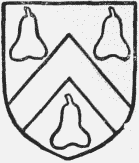
Abbot. Gules a cheveron between three pears or.
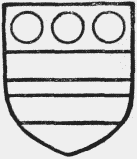
Wake. Or two bars gules with three roundels gules in the chief.
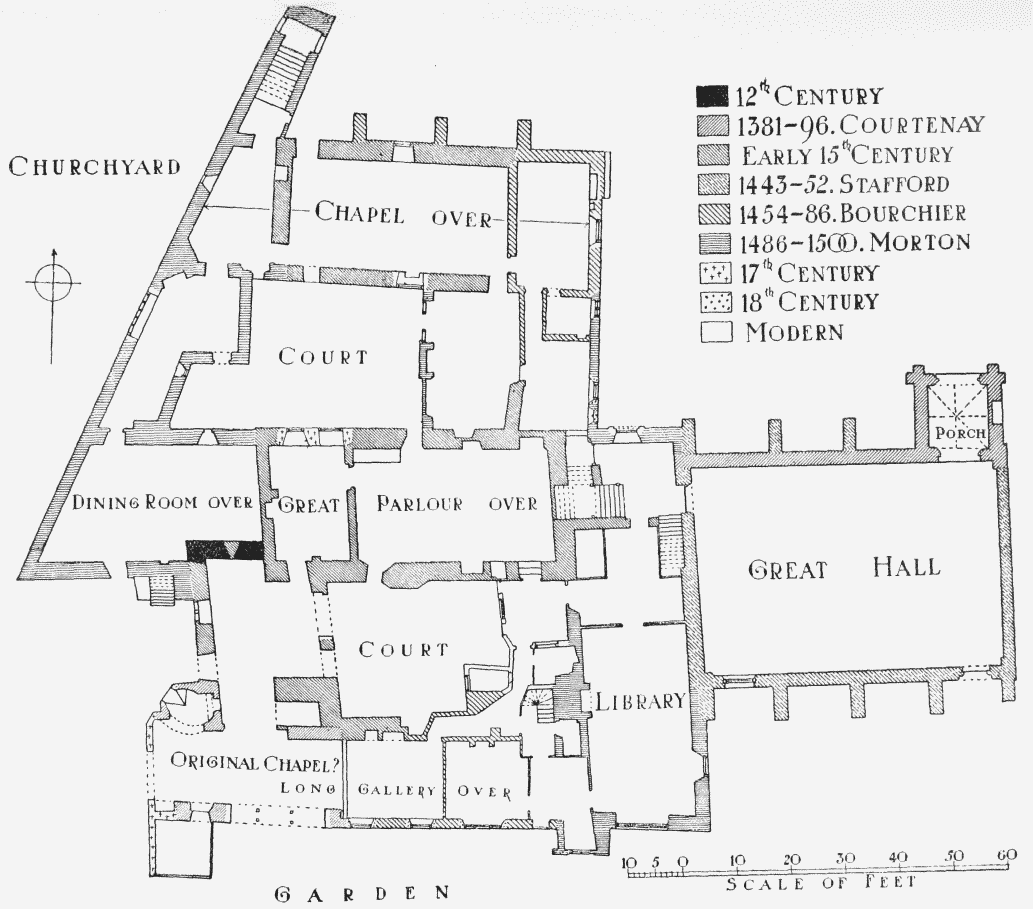
Ground plan of Croydon Palace
The vaulted porch at the north-east is of the late 14th century. At the angles are buttresses of ashlar work of one offset. The arch of the entrance is two-centred, and the mouldings are stopped by imposts, below which the jambs are moulded in two orders with three-quarter rounds and hollow chamfers. The vault of the porch has diagonal, transverse and wall ribs, with carved bosses at their intersections. The diagonals originally sprang from head corbels, of which one only is now left, that in the south-west angle. The parvise over was doubtless entered from the gallery over the screens, but is now reached by a modern staircase from the hall. It is lighted by a window of two lights with a square head and label in the north, and by a recently opened single light in the west wall. There is some 17th and 18th-century panelling, but no fittings or an earlier date remain. Externally the walls are stuccoed, and the stonework of the entrance has been drastically restored. In the north wall is a tablet with the date 1748, commemorating a repair by Archbishop Herring.
The moulded ceiling of the lobby between the hall and the great parlour belongs to Morton's rebuilding. The stairs to the great parlour and to the first floor are of 17th-century construction. The library on the south of the lobby has a modern plastered ceiling, which probably conceals moulded timbers. The basement of the block connecting with the chapel is now occupied by a cloak-room, with the kitchen on the courtyard side. The partition between is partly of stone and partly of timber and plaster, the stone portion probably representing the earlier building. The doorway to the kitchen has moulded oak posts and four-centred head. A stone doorway with a head of the same form leads to the basement of the east end of the chapel. The walls of these portions are of brick, and in the east wall of the chapel basement is a small niche with moulded jambs and four-centred head, in which a small grate has been inserted in modern times. From its position, a little to the north of the centre of the wall, it cannot have been a piscina, and was probably intended for some domestic purpose. A cross wall of narrow bricks cuts off the basement of the central portion of the chapel, the walls of which are of considerably greater thickness and are of flint rubble. This cross wall probably represents the position of the earlier east wall, the brickwork to the east of it belonging to Bourchier's rebuilding. In the exterior of the north wall a blocked four-centred window is visible. No earlier detail remains. A cross wall of the same material marks the original western limit of the chapel, beyond which is Morton's extension, entirely of brick. The floor of the chapel is carried by a central longitudinal beam supported by massive baulks of timber. The basement of Morton's annexe retains no features of interest.
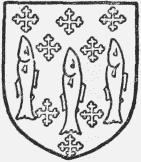
Herring. Azure crusilly or three herrings argent.
The basement of the buildings on the west side of the south courtyard, with the portion beneath the same end of the long gallery range, appear to date partly from the 12th century and partly from the 14th and 15th centuries, the line of the walls of the earliest date being probably followed. The north-west wall, which adjoins the west wall of the great parlour, contains a blocked roundheaded light, showing it to be of the early 12th century. The basement at the west end of the long gallery appears, for the reasons given above, to be Courtenay's secretior capella, and to occupy the site of the chapel of the original manor-house. The doorway at the south-west has a two-centred head and square outer order with quatrefoil spandrels. On the north are the remains of a newel stair, probably leading to Courtenay's camera secreta, all traces of which have disappeared. This portion also is of flint rubble, but has been much repaired and refaced at subsequent periods. A brick-nogged partition has superseded the original east wall. The remaining portion of the basement of the long gallery has been divided by modern partitions.
The great parlour known as 'Arundel's hall' or the guardroom measures internally 51 ft. by 21 ft. It is approached from the lobby at the west end of the great hall by a 17th-century stair. The doorways in the east and west walls appear to have been enlarged in the early 18th century. The upper part of the west wall was formerly open to the room on the second floor known as the minstrels' gallery, which forms part of Morton's extension. This opening has recently been closed with match-boarding. In the centre of the south wall is a bay window which was of original date, but has been almost entirely renewed within the last few years. The lights have uncusped two-centred heads and are divided by characteristically moulded mullions and transom. To the eastward of this is a large 17th-century window with wood mullions and transom. In the north wall is a large window of similar date and type, and to the west of it a fireplace of early 18th-century date. The open timber roof is concealed by a plaster ceiling, the arched braces being left exposed. These are elaborately moulded, and form four-centred arches. Their feet are supported by corbels carved with angels, all, with the exception of those of the wall trusses, holding shields. On the corbels of the north wall are Canterbury impaling Arundel, and a passion shield; on the south wall Arundel and Canterbury. Externally the walls, which are of flint rubble, have been much disturbed by later alterations and in some places have been refaced with brick. The quoin stones at the north-west angle are clearly visible, and a slight break marks the junction with Morton's work to the westward. On the south wall is a modern brick buttress.
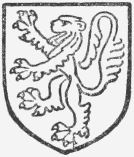
Arundel. Gules a lion or.
The chapel, including Morton's extension, measures internally about 70 ft. by 24 ft. The walls are of thin brickwork, and there are brick buttresses of two offsets on the north. The chapel, as rebuilt late in the 15th century, probably by Archbishop Bourchier, seems to have been lengthened eastwards about 13 ft., the eastern portion from the ground upwards being entirely of brick, though faced with flint on the north external face to a height corresponding with the older wall westward, upon which the brick superstructure is built. The beginning of Morton's westward extension is marked by a break in the brickwork on both north and south walls, nearly corresponding with the position of the screen internally. The courses of the newer work are slightly deeper. The east window is of seven uncusped lights, within a low pitched, straight-sided head. There are three windows in the north wall and two in the south, each of five similar lights within a square head. The mullions are moulded with an ogee and hollow chamfer. At the south-east is a small doorway leading to the connecting block on the east side of the north courtyard. This has an oak four-centred head and posts, with a continuous moulding, of an earlier section than, and perfectly distinct from, the mouldings found in Morton's work to the west of the screen. The west wall follows the slant of the churchyard boundary, and the west window was originally of four lights within a four-centred head. These are now blocked, with the exception of the upper part of the two centre lights. Immediately above are a pair of keys in saltire, with other patterns in blue brick, and in the gable over is a small blocked light. In the south-west angle of the chapel is a small doorway leading to the cross block on the west side of the north courtyard. This has a square head and posts of oak with elaborate mouldings of the type found throughout Morton's work both here and at Lambeth, consisting of clustered rolls and flat, or very slightly hollowed, chamfers. A similar doorway, but considerably larger, leads to a flight of steps at the north-west. These steps are contained in a small building, the eastern wall of which lines with the chapel wall. At the foot are doorways with four-centred heads opening to the grounds of the palace and to the churchyard. It may be noted that the jamb mould is similar to that of the entrance door to the audience chamber in Morton's tower at Lambeth. The roof has a 17th-century boarded ceiling with moulded ribs, only the arched tie-beams of the original roof being exposed. These seem to have been carried originally by continuously moulded wall posts, since cut away. The western truss appears to be of later date, and may have been added when the roof was ceiled. The wall posts to this truss still remain. The screen is divided into five main compartments by elaborately moulded uprights. The central and narrower compartment is occupied by a two-leaved door, the styles of which are rebated to fit corresponding rebates in the main uprights, which are cut away to receive them, the styles of the doors, when closed, completing the suite of mouldings. The lower part of each side compartment is divided into three panels by moulded uprights, the upper part having six open lights. The rail which forms their sill is carved with a cusped running ornament. The whole is crowned by a casement moulded and embattled cornice, with an applied vine ornament of soft wood, on which appears the rebus described above.
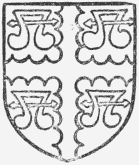
Bourchier. Argent a cross engrailed gules between four water bougets sable.
In the 18th century a canopied stall of deal was constructed on the south side of the entrance, the cornice of which is continued above the original embattled cornice. The stalls seem to have been rearranged by Archbishop Juxon, who made use of parts of Bourchier's stalling, to which belong the bench ends on either side of the doorway of the screen, one of which has been worked into the 18th-century stall above referred to. On the elbows are the heads of a man and a boy, wearing the typical cap of the period, and the finials are vigorous half poppy-heads. The desks in front are apparently the work of Juxon. The fronts are panelled, and the finial of each desk-end is carved on both sides with oval shields and mantling. The shields on the north finial are Canterbury, and the deanery of Gloucester, both impaling Laud; on the south, St. John's College, Oxford, and London, both impaling Laud. On the north and south sides of the chapel are three sets of stalls, the western set being the return of the screen stalls. These with the eastern stalls are also Juxon's work, but the desks of the centre set on both sides are remains of the Bourchier stalling, the ends having bold poppy-heads. The stalls themselves are more properly plain benches, with backs of wainscot. The finials of the eastern desk-ends have shields with Canterbury impaling Juxon repeated four times, while those of the western desk-ends have St. David's and Bath and Wells both impaling Laud. The panelling on the east wall is of 18th-century date. There are coupled Corinthian pilasters on either side of the east window, and plain panelling beneath the sill. At the south-west angle is a large pew, or rather gallery, entered by a flight of steps against the west wall, and by a doorway from the second floor of the cross block on the west side of the north courtyard. This appears to have been the work of Laud, both from its style, and from his arms, which are carved upon the front. The altar rails are of early 17th-century date, and had till recently been utilized as the rails of the so-called minstrels' gallery at the west end of the great parlour.
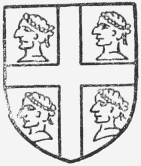
Juxon. Or a cross gules between four blackamoors' heads in their proper colours with wreaths or.
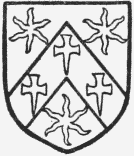
Laud. Sable a cheveron between three stars or with three crosses formy fitchy gules in the cheveron.
In the cross block on the west side of the north courtyard is a small room entered from the doorway at the south-west angle of the chapel. This has the moulded ceiling joists and a fireplace with a four-centred head of moulded brick, partly concealed by an 18th-century surround of wood. Opening out of this to the south is a small lobby, in which a 17th-century staircase leading to the floor above has been inserted, a portion of the moulded ceiling being cut away for the purpose. This lobby opens directly into the dining-room, the large apartment at the west end of the great parlour. The walls have 18th-century panelling, but Morton's moulded timber ceiling remains intact. Over the dining-room is the room erroneously known as the 'minstrels' gallery,' which has a high-pitched open timber roof of very light scantling. The second floor of the cross block answers in arrangement to the floor below. The elevation towards the churchyard is flush with the west gable of the chapel, to which the gable of the 'minstrels' gallery' answers on the south. The dining-room is lighted in this wall by an 18th-century sash, and the 'minstrels' gallery' by an original stone window of two four-centred lights with a square head and external label. The remaining windows of this elevation are stone four-centred lights of good proportion. There is occasional diapering of blue brick throughout.
The first floor of the building on the west side of the south courtyard consists of a large room which may represent the solar of the original manor-house. The east wall appears to have been rebuilt by Morton above the ground floor level, and the roof is comparatively modern. It is lighted in this wall by two windows, the northern a stone window of two lights of original date; the southern window is modern. A door at the south-west opens on to the ruined newel stair. A hanging gallery of half-timber against the outside of the west wall gives access to the south or long gallery range. This has been divided into two rooms, and there is a small projecting wing at the south-west, probably of 17th-century date. The west wall of this is of brick, and the south and east walls merely of weather-boarded timber framing. Much early 17th-century panelling remains in the long gallery, and in the north wall facing on the south courtyard are the remains of a blocked oriel window of halftimber divided from the long gallery by a wide opening with a four-centred head and continuously moulded uprights of oak, and two narrower compartments on either side, which appear to have been filled with some sort of screen work. This portion of the palace, as stated above, appears to be the work of Bourchier, to judge from the character of the mouldings of the surviving detail. The walls seem to be of half-timber construction, though faced with brick in the early 18th century on the south and plastered over on the courtyard side. The southern windows all belong to the 18th-century refacing. There is no attic floor.
The room which occupies the southern end of the block of building between the hall and great parlour, and now known as 'Queen Elizabeth's room,' is at once recognizable as the work of Morton by the moulded joists of the ceiling revealed by the stripping away of a portion of the modern plaster ceiling. In the south wall is an 18th-century window, and in the east a window looking into the hall, probably of 17th-century date. A 17th-century staircase at the north-east leads down to the lobby between the hall and the great parlour. The remainder of the block is occupied on this floor by two rooms, one of which has 18th-century panelling, and is consequently known as 'the panelled room.' At the southern end of the roof are attics, the remainder, which seems to belong entirely to Morton's reconstruction, being left as a loft, and lighted by an original two-light window on the north. On the south elevation a narrow entrance porch continued the whole height of the building abuts upon the long gallery and interrupts the western slope of the main gable at about half its height. The porch is crowned by a small gable, in which is a small blocked light. The windows of this wall and the return wall on the east are 18th-century insertions. At the east end of the ground stage of the south wall is a pattern in blue brick which may be intended to represent an archbishop's cross.
The first floor of the cross block on the east side of the north courtyard is two rooms in depth and is reached from the main staircase, which gives access to the great parlour. The large room on the east side appears to have been heightened late in the 17th century, to which date the panelling belongs. A portion of the original ceiling on the west side shows the original height. At the north-east is the doorway opening into the chapel, described with it, and in the centre of the west wall is a modern bay window with two sash windows on either side. These latter seem to occupy the original openings. The rooms adjoining on the west have the moulded timber ceilings found everywhere else in Morton's work, and render it certain that this block was reconstructed by him. The staircase leading to the attics is the only original staircase remaining. There are two rooms on the west side of the roof. The northern room has an extremely elaborate moulded timber ceiling, the joists being sloped slightly upward and abutting upon an elaborately moulded ridge piece. The partition on the east is panelled, with finely moulded uprights, and is an exceptionally good example of late 15th-century joinery. The walls are of brick with occasional diapering.
The secular building next in importance to the palace is the hospital of the Holy Trinity, generally called Whitgift's Hospital, which was founded by Archbishop John Whitgift in 1596 (see under charities). It stands at the corner of George Street and North End, the entrance front facing upon the latter thoroughfare. The buildings are two-storied and surround an interior quadrangle measuring about 76 ft. by 82 ft. The materials are red brick, with occasional diapering of black brick and stucco dressings. The roofs are tiled. In the centre of the front to North End is the entrance gateway, with a passage through, and there is a corresponding gateway and passage in the centre of the range of buildings on the opposite, or eastern, side of the quadrangle. Over these portions there is a third floor, the walls being carried above the eaves and crowned by gables. The hospital contains nine houses, each entered by a door from the quadrangle and containing four rooms, one room being allotted to each inmate. The chapel, measuring internally 21 ft. 4 in. by 14 ft. 6 in., is at the south-east corner, of the height of two stories, and occupies the south end of the eastern range. The upper floor of this range, to the north of the gateway, and including the rooms over it, is occupied by the warden's apartments. The ground floor on the same side of the gateway is occupied by the hall, which measures internally 24 ft. 7 in. by 14 ft. 6 in., and at the north end by a wash-house, answering in size and position to the chapel. Over the entrance gateway in the western range is a room, which was formerly used as a muniment room; the room above this is now a clock loft. The remaining portions of the east and west ranges and the whole of the connecting ranges on the north and south sides are occupied by the houses of the inmates. The room adjoining the entrance gateway on the south is now used as the secretary's office. The building underwent a general repair in the earlier years of the 19th century, and was further 'restored' in 1860, at which date all the chimney-stacks were rebuilt, with the exception of that on the north side of the gatehouse in the eastern range. The chapel and hall doorways and the gable over the quadrangle face of the entrance gateway were also altered to their present forms. The flint plinth facing throughout the buildings belongs probably to this restoration. The central feature of the north end elevation is formed by the gateway and the gable above; the roofs of the north and south ranges are also terminated by gables which give an effective finish to the elevation. The central gateway has a semicircular head surmounted by a shallow entablature and broken pediment, all of stucco. On the frieze is inscribed 'Qui Dat Pauperi Non Indigebit.' On the pediment are the arms of the see of Canterbury. Above is a panel with a mitre in relief upon it. Between the windows of the third floor is a panel inscribed 'The Hospital of the Holy Trinity.' These details appear to be modern, with the exception of the gateway. In the gable are the initials I.C. in brick. The windows are of two lights, with stucco dressings, and have stout oak frames with ovolo moulded mullions. The windows of the ground floor have labels. The flint-faced plinth, as mentioned above, is probably modern. The angles are finished with painted plaster quoins, and the ungabled portions of the wall are crowned by a moulded brick cornice, the effect of which is now spoilt by projecting the rafters of the roof beyond it. The gables have brick diapering. In the southern gable are the initials I.W. in brick. The east, or back, elevation is similar but plainer. At the south end is the east window of the chapel. This is of three cinquefoiled lights with vertical tracery within a two-centred head and external label. Above it is a panel inscribed in Roman capitals, 'Eboracensis | Hanc Fenestra (sic) | Fieri Fecit | 1597.' On the quadrangle side the gateways have four-centred heads. These, with the jambs, are plastered, and have the appearance of early 19th-century work. The warden's room over the gateway in the eastern range has an 18th-century sash window, neatly labelled and dressed in the 'Gothic taste.' The doorways to the houses, though much patched up, still retain their original moulded heads and posts. Projecting tiled hoods, added in 1860, besides destroying the original simplicity of the doorways themselves, injure very seriously the effect of the whole quadrangle. The doorways to the hall and chapel are modern. The windows of the rooms looking on to the quadrangle are mostly of three lights, with oak frames similar to those of the external elevations. In the central gable is a modern clock-face. A modern flèche is perched upon the roof ridge. In the centre of the walls of the north and south ranges stone tablets of hideous form record the foundation of the hospital by Archbishop Whitgift in 1596 and its restoration in 1860 during the wardenship of John Penn.
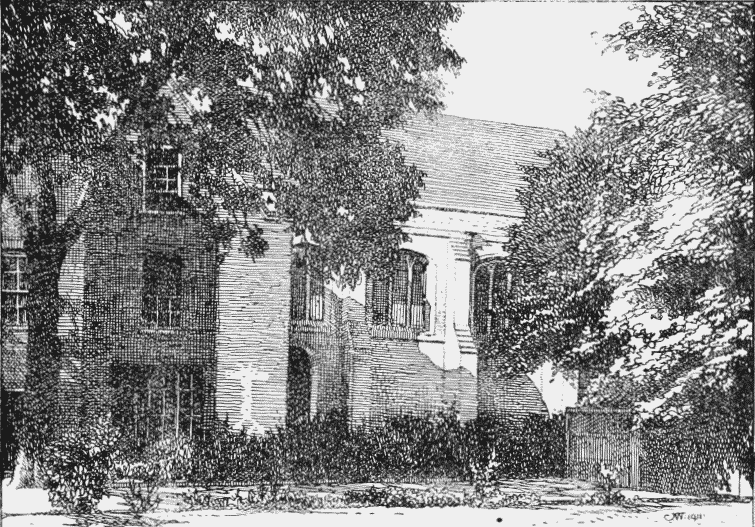
Archbishop's Palace, Croydon: The Greatest Hall and Library from the South
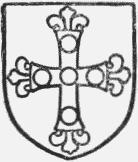
Whitgift. Argent a cross sable flowered at the ends with five bezants thereon.

Whitgift's Hospital, Croydon : North-west Angle of the Quadrangle.
The hall is entered by a modernized doorway immediately to the north of the gateway in the eastern range, at the side of the chimney breast at its southern end. The fireplace has a moulded fourcentred head and jambs. Some fragments of original glass remain in the windows. In the southernmost window of the east wall are the arms of Edward Aylworth, who is stated in a modern inscription beneath to have paid for the glazing of the casements in the hall at a cost of £3 4s. 4d. The arms are: Quarterly (1) Argent a fesse engrailed between six billets gules, on the fesse a crescent or for difference, for Aylworth; (2) Argent a molet sable, for Ashton; (3) Vert a fesse dancetty ermine, for Summers; (4) Argent a cheveron purpure between three perukes sable, for Harman. On either side of the shield are caryatid figures, and the whole is surrounded by strapwork ornament and festoons of fruit and flowers. On a panel immediately below is inscribed 'Edwardus Aylworth | Anno 1598.' In the northernmost window of the west wall are the arms of Queen Elizabeth encircled by the garter. This has been much restored, but portions appear to be original. In the same window are the arms of Archbishop Benson, surrounded by a border made up of fragments of old glass. In the southern window of the same wall are the arms of Whitgift (the see of Canterbury impaling Argent a cross sable flowered at the ends with five bezants thereon). This appears to be modern. In the same window is an original fragment consisting of a four-arched crown with the motto beneath Vincit Qui Patitur. The glass was restored in 1887, to which date the modern pieces probably belong. Between the windows of the east wall is a wood panel, on which is painted Whitgift's reply to his enemies :—
'Feci quod potui, potui quod, Christe, dedisti, Improba fac melius (si potes) Invidia.'
Two fragments of the inscriptions on his tomb in Croydon Church, which was destroyed by fire in 1867, are preserved here. A small staircase, entered from under the gateway on the east side of the chimney breast at the south end of the hall, leads to a large apartment immediately over it. At the head of the stairs is a doorway, with moulded posts and head, which still retains its original door. This is in two thicknesses with nine panels on the face. The fireplace is of stone with moulded four-centred head and jambs. Above is an elaborately panelled overmantel, with a central panel carved with the arms of Archbishop Whitgift. The original panelling of the room still survives. The glass in the windows is plain. Here are preserved a fine Armada chest and a small bell, dated 1753, which is no longer in use. Adjoining this room upon the north is the warden's kitchen. At the opposite end, over the gateway, is a small panelled room, and on the floor above a bedroom, reached by a small staircase opening out of it at the side of the chimney immediately over the staircase below leading to the large room. These rooms, which are said to have been frequently occupied by Archbishop Whitgift, still retain the greater part of their original fittings. The bedroom door has locks of a most elaborate nature, two of them having their keyholes concealed by screw heads resembling the nail heads with which the door is studded. The chapel is a small apartment at the south end of the same range and occupies its whole height. The entrance is in the south-east angle of the quadrangle. As stated above, the doorway has been modernized. The three-light east window has been already described with the exterior. In the south wall are two square-headed windows of two lights with four-centred heads. Round the lower part of the walls is original wainscoting, above the walls are plastered and there is a plain flat plastered ceiling; the original benches, four rows on the north side and five rows on the south side, with a central passage and a long bench against the west wall, still survive. They are without backs and their ends have finials of poppy-head outline. On the west wall is a portrait of Whitgift, painted on a panel of wood, surrounded by an elaborate frame of architectural design, surmounted by his arms. He is represented as standing at a table with an open Bible before him. On the bottom of the frame is inscribed the following couplet :—
'Has Triadi sanctae primo qui struxerat aedes Istius en veram Praesulis effigiem.'
On the north wall is hung a wooden tablet with the arms of Whitgift painted in the centre and surrounded by appropriate quotations from the Fathers inscribed on painted strapwork panels. The ground of the whole composition is ornamented with fruit and flowers. The panel is ornamented by a pediment inscribed 'I.W. 1600.' On this wall is also a portrait of a lady inscribed in the top dexter corner 'Ano:D[omini]: 1616, | Aetatis Suae; 38.' On the east wall is hung a folding panel upon which are painted the Ten Commandments. A similarly inscribed panel with figures of Moses and Aaron, with an elaborately designed frame, is hung on the south wall. Near the seat on the north wall is hung a framed figure of Death, and on the south wall what appears to be a copy of a laudatory Latin poem; both have been varnished over and are now almost indecipherable.
Elys Davy's Almshouses, founded in 1447, stand in Church Street. The original 15th-century building has disappeared. Seven houses of the north block appear to date from the 18th century. These are of two stories, and are built of red brick with tiled roofs. Five houses were added to this block in 1875. A new south block containing eight houses was built in 1887.
Some of the ancient inns at Croydon still remain. The Greyhound Hotel in High Street is an old establishment, mention being made of 'the good wyfe of the Grewond' in the parish register for 1563. The 'Crown' and the 'Swan' are both mentioned in the latter part of the 16th century. (fn. 31) Mention is made of the George Inn at Croydon in 1648, (fn. 32) and the 'Green Dragon' was another great coaching house.
In 1809 a town hall was built to replace the old market-house, pulled down in 1807 (see below). This building stood in High Street, and was in a pseudo-classical style. The present town hall was erected in 1893–4 on the site of the former Central Croydon railway station, in the Renaissance style with a lofty tower. Besides the usual municipal offices and courts it contains the Croydon Library, founded in 1890, which now includes about 40,000 volumes. It has branches at Laurence Road, South Norwood, High Street, Thornton Heath, and conjointly with Lambeth at Weston Hill, Upper Norwood. It also contains the great series of views belonging to the Photographic Survey and Record Society of Surrey, which was founded in 1902 for the systematic record of architectural and picturesque features of the county. There is also a valuable museum of local and general collections in archaeology, geology, and natural history.
In North End stands the Whitgift Grammar School. The present building was opened on 4 March 1891. The Whitgift Middle School is situated in Church Street, Old Town. (fn. 33) In Wellesley Road is the Girls' Public Day School Company's school, and not far from this is Merton College. Among other modern buildings in Croydon mention may be made of the Royal Masonic Benevolent Institution in St. James' Road, founded in 1850. The Croydon General Hospital in the London Road was opened in 1870 by the Archbishop of Canterbury.
Four hundred years ago there was an important charcoal-burning industry in Croydon. The 'Croydon Colliers' were proverbial. (fn. 34) They supplied London with charcoal, which was made in the then extensive woods. 'Grim the Collier of Croydon' was a well-known personification of the vice or fool in early drama. An attempt was made early in the 19th century to establish the trades of calico printing and bleaching in Croydon, and a calico printing mill was erected near the edge of the large pond at the back of Church Street, where the water was diverted to turn a wheel, but, not being successful, it was soon given up. (fn. 35) The firm of Messrs. C. T. Brock & Co. moved their Croydon firework factory to Norwood in 1895, in consequence of their displays at the Crystal Palace. In the brewery industry Croydon is represented by the firms of Messrs. Crowley, Messrs. Nalder & Collyer, and Messrs. Page & Overton. Messrs. White & Sons have large works at Croydon for the manufacture of ginger beer and other mineral waters. The ironworks of Messrs. H. & G. Measures are also in the parish.
The Bourne, or intermittent spring issuing near Croydon Church, which flows sometimes in great volume in the winter, was once famous. Warkworth alludes to it in the 15th century as one of the springs whose flow presaged disasters in the state. (fn. 36) It is not so frequent or so copious as formerly owing to the extensive tapping of the water supplies in the chalk by various water companies, but it still occasionally lays the neighbourhood under water.
There are still some remains of the extensive woods which covered this neighbourhood. Grange Wood lies to the east of the road from Croydon to Norwood, and Biggin Wood and Hazelwood are other surviving names.
Croham Hurst, consisting of over 80 acres on a wooded hill south of Croydon, is reserved for the use of the public by the Croydon Corporation. The place is not only beautiful for its trees and views, but is interesting as containing prehistoric hut circles and has yielded a number of neolithic remains (see above). The other public recreation grounds are Addington Hills, Addiscombe recreation grounds, Brighton Road recreation ground, Duppas Hill, Grange Road Park, Park Hill, South Norwood Common, Wandle Park, Whitehorse Road recreation ground, Woodside Green and Hermitage sports ground at Norbury.
The Waldrons is the name of a district occupying a high ridge of gravel soil, now covered with houses and villas. According to a writer of the early 19th century it was attached to the Haling estate, and consisted of about 12 acres inclosed by a park fence.
Among the more important houses in Croydon are Waddon House, the residence of Mr. J. Warner, and Waddon Lodge, of Mr. N. Waterall. Other large houses in the neighbourhood are Bramley Croft, the residence of Sir F. T. Edridge, D.L., J.P.; The Homestead, Bedford Park, of Mr. Alfred Walton; Grange Mount, Upper Norwood, of Sir William Treloar, bart.; Coldharbour, the residence of Mr. D. W. Barker; Croham Hurst, of Mr. A. H. N. Kemmis, D.L., J.P.; Bramley Hill Side, of Mr. E. H. Lamb, C.M.G., M.P., J.P.; Croham House, of Mr. E. W. Grimwade, J.P.; Hill Crest, Brownlow Road, of Sir Thomas Vansittart Bowater; The Cedars, Morland Avenue, of Mrs. E. Sharp; Haling Grove House, of Mr. S. Shorter; Coombe Lodge, Coombe Road, of Mr. J. J. Reid; Coombe Cliff, Coombe Road, of Mr. Alderman Allen, J.P.; Coignafearn, Pampisford Road, of Mr. W. B. Secretan; and Woodside, Pollard's Hill North, of Mrs. Brown. At Norbury are Norbury Hall, the residence of Mr. J. W. Hobbs; Norbury Lodge, of Mr. H. S. Cooper-Clarke; Norbury House, of Mr. H. H. Castle; Hill Crest, of Mr. S. Taylor-Coleridge; and Oakdean, of Mr. C. K. Thomas.
The district of Upper Norwood lies within the parish of Croydon, West Norwood being situated in Lambeth. Vicar's Oak, which must have stood in the district now known as Upper Norwood, stood at the meeting-place of four parishes—Lambeth, Camberwell, Battersea and Streatham. The whole of Norwood was an outlying wood belonging to Croydon Park. The inhabitants of Croydon had herbage there for all kinds of cattle, mast for their swine and all the furze, bushes, broom and underwood growing there. (fn. 37) At the beginning of the 19th century Norwood was described as a 'hamlet scattered round an extensive common.' (fn. 38) The gipsies who frequented this common have left their name in Gipsy Hill. (fn. 39) Spa Hill and Spa Road mark the site of Beulah Spa, opened in 1831. A residential town of considerable size has sprung up during the last century. The Royal Normal College for the Blind was founded in 1871 and first occupied a house near the Low Level railway station, but its rapid growth necessitated its removal to the buildings on Westow Hill. (fn. 40) The Jews' Hospital and Orphan Asylum at Knight's Hill, West Norwood, was built in 1876. There is a small synagogue within the buildings. The Westmorland School on Tulse Hill, founded by the Westmorland Society, was opened in 1854. It was primarily intended for the children of natives of Westmorland born in London, but children born in Westmorland are now admitted. The Lambeth Parochial School in Elder Road was founded in 1815. The old buildings are now used for the infants' school; the new buildings were opened in 1885. The free library near Knight's Hill Road was built in 1888. (fn. 41)
A number of people of literary or other importance have been connected with Croydon and its neighbourhood. Thackeray lived at Addiscombe with his mother and stepfather, Mrs. and Major Smyth, after their return from India in 1821. His stepfather, Major H. W. C. Smyth, of the Bengal Engineers, author of a Hindoostanee Dictionary and Jest Book, was for some time superintendent of the East India Company's military college at Addiscombe. Sir Richard Gurney, the Royalist lord mayor, was born at Croydon in 1577. Connected with Duppas Hill is Sir Francis Bond Head (1793–1875), who, after beginning life as a Royal Engineer, was in 1825 appointed manager of the Rio Plata Mining Association and went to South America with a staff of Cornish miners. This enterprise, however, proved entirely unsuccessful. In 1835 he was sent as lieutenant-governor to Upper Canada, and, although not possessed of any colonial training, he filled this post with distinction. After his return in 1838 he was best known as a Quarterly Reviewer. He died at his house at Duppas Hill in 1875. Among minor celebrities may be mentioned Daniel Quare, the inventor of repeater watches and clockmaker to the king, who died at his house in Croydon in 1734; William West, bookseller and antiquary, who was born at Waddon in 1770, and Samuel Bentley, printer and antiquarian, author of Excerpta Historica, who lived at Croydon after retiring from business in 1853. Michael Murgatroid, a Greek scholar and author, was successively secretary, comptroller and steward of the household to Archbishop Whitgift, and leased a farm from him at Waddon, where he died in 1608. He was buried in the chancel of Croydon Church as near Archbishop Whitgift as possible. Henry Thrale, husband of Mrs. Thrale, the friend of Dr. Johnson, had a house at Streatham Park and kept a pack of hounds and hunting-box near Croydon.
The assizes up to a recent date were held alternately at Guildford and Croydon. The court-house, of which the upper story was used for the trial of civil causes and the ground floor as a criminal court, was built in 1809. A court of requests was also held here every alternate week for the recovery of debts under £5. (fn. 42) Fuller, speaking of the Black Assizes at Oxford in 1577 and of the other two at Hereford in the reigns of James I and Charles I, adds: 'The like chanced some four years since [1650] at Croydon, in Surrey, where a great depopulation happened at the Assizes of persons of quality, and the two judges Baron Yates and Baron Rigby getting their Banes there, died a few days afterwards.' (fn. 43) The petty sessions are now held at Croydon every Saturday and a police court is held daily, but the assizes are no longer held there.
The first railway line built and sanctioned by Parliament ran from Wandsworth to Croydon. (fn. 44) It was part of a scheme proposed in 1799 for linking up London with Portsmouth by an iron railroad running through Croydon, Reigate and Arundel; but only the section from Wandsworth to Croydon was at first laid down. It was afterwards extended to Merstham, (fn. 45) but proved a complete failure. (fn. 46) The London and Croydon railway was incorporated in 1835 (fn. 47) and the London and Brighton in 1837. By its Act of Incorporation the latter company was given power to purchase the whole of the railway from Croydon to Merstham. (fn. 48) The London and Croydon and London and Brighton railways were amalgamated under the name of the London, Brighton and South Coast railway by Act of 1846. (fn. 49) There are now four stations in Croydon belonging to the London, Brighton and South Coast and South Eastern railways. The Croydon Tramways Company was incorporated in 1894. (fn. 50) Before the opening of the railways some fifty stage coaches went every weekday through Croydon. From the town of Croydon itself there were six four-horse coaches and five or six pair-horse coaches daily to London and back. There were the white coaches and the red, which belonged to opposition companies. Their chief stopping-place was the 'Green Dragon'; for the local service between Croydon and London, however, passengers booked at the 'Crown.' (fn. 51)
In 1801 an Act of Parliament was obtained for the making and maintaining a navigable canal from the town of Croydon to join the Grand Surrey Canal in the parish of St. Paul, Deptford. The proprietors were to supply Croydon, Streatham, Dulwich, Norwood and Sydenham with water. (fn. 52) The route followed by the canal, which was opened in 1809, was almost precisely the same as the present London and Croydon railway. This canal was never financially a success, and in August 1836, having been purchased by the London and Croydon Railway Company, (fn. 53) it was closed. A few traces of it are still visible at Anerley and Norwood. The terminus basin was at West Croydon, on the spot where the West Croydon station now stands. (fn. 54)
